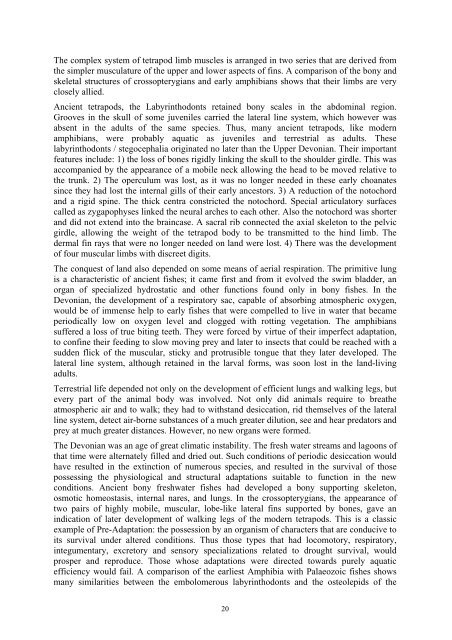Animal Diversity: Chordata
Animal Diversity: Chordata
Animal Diversity: Chordata
You also want an ePaper? Increase the reach of your titles
YUMPU automatically turns print PDFs into web optimized ePapers that Google loves.
The complex system of tetrapod limb muscles is arranged in two series that are derived from<br />
the simpler musculature of the upper and lower aspects of fins. A comparison of the bony and<br />
skeletal structures of crossopterygians and early amphibians shows that their limbs are very<br />
closely allied.<br />
Ancient tetrapods, the Labyrinthodonts retained bony scales in the abdominal region.<br />
Grooves in the skull of some juveniles carried the lateral line system, which however was<br />
absent in the adults of the same species. Thus, many ancient tetrapods, like modern<br />
amphibians, were probably aquatic as juveniles and terrestrial as adults. These<br />
labyrinthodonts / stegocephalia originated no later than the Upper Devonian. Their important<br />
features include: 1) the loss of bones rigidly linking the skull to the shoulder girdle. This was<br />
accompanied by the appearance of a mobile neck allowing the head to be moved relative to<br />
the trunk. 2) The operculum was lost, as it was no longer needed in these early choanates<br />
since they had lost the internal gills of their early ancestors. 3) A reduction of the notochord<br />
and a rigid spine. The thick centra constricted the notochord. Special articulatory surfaces<br />
called as zygapophyses linked the neural arches to each other. Also the notochord was shorter<br />
and did not extend into the braincase. A sacral rib connected the axial skeleton to the pelvic<br />
girdle, allowing the weight of the tetrapod body to be transmitted to the hind limb. The<br />
dermal fin rays that were no longer needed on land were lost. 4) There was the development<br />
of four muscular limbs with discreet digits.<br />
The conquest of land also depended on some means of aerial respiration. The primitive lung<br />
is a characteristic of ancient fishes; it came first and from it evolved the swim bladder, an<br />
organ of specialized hydrostatic and other functions found only in bony fishes. In the<br />
Devonian, the development of a respiratory sac, capable of absorbing atmospheric oxygen,<br />
would be of immense help to early fishes that were compelled to live in water that became<br />
periodically low on oxygen level and clogged with rotting vegetation. The amphibians<br />
suffered a loss of true biting teeth. They were forced by virtue of their imperfect adaptation,<br />
to confine their feeding to slow moving prey and later to insects that could be reached with a<br />
sudden flick of the muscular, sticky and protrusible tongue that they later developed. The<br />
lateral line system, although retained in the larval forms, was soon lost in the land-living<br />
adults.<br />
Terrestrial life depended not only on the development of efficient lungs and walking legs, but<br />
every part of the animal body was involved. Not only did animals require to breathe<br />
atmospheric air and to walk; they had to withstand desiccation, rid themselves of the lateral<br />
line system, detect air-borne substances of a much greater dilution, see and hear predators and<br />
prey at much greater distances. However, no new organs were formed.<br />
The Devonian was an age of great climatic instability. The fresh water streams and lagoons of<br />
that time were alternately filled and dried out. Such conditions of periodic desiccation would<br />
have resulted in the extinction of numerous species, and resulted in the survival of those<br />
possessing the physiological and structural adaptations suitable to function in the new<br />
conditions. Ancient bony freshwater fishes had developed a bony supporting skeleton,<br />
osmotic homeostasis, internal nares, and lungs. In the crossopterygians, the appearance of<br />
two pairs of highly mobile, muscular, lobe-like lateral fins supported by bones, gave an<br />
indication of later development of walking legs of the modern tetrapods. This is a classic<br />
example of Pre-Adaptation: the possession by an organism of characters that are conducive to<br />
its survival under altered conditions. Thus those types that had locomotory, respiratory,<br />
integumentary, excretory and sensory specializations related to drought survival, would<br />
prosper and reproduce. Those whose adaptations were directed towards purely aquatic<br />
efficiency would fail. A comparison of the earliest Amphibia with Palaeozoic fishes shows<br />
many similarities between the embolomerous labyrinthodonts and the osteolepids of the<br />
20

















